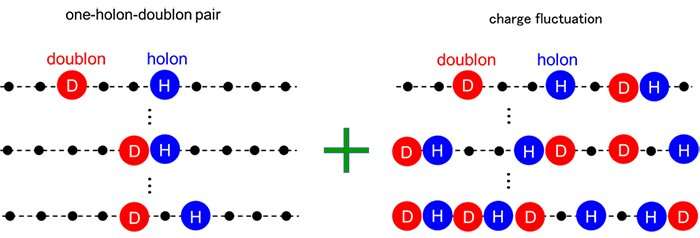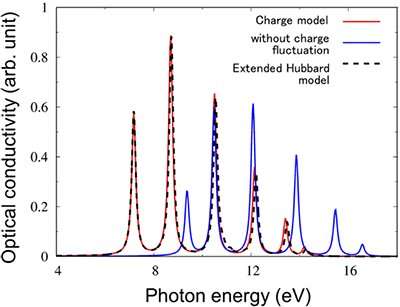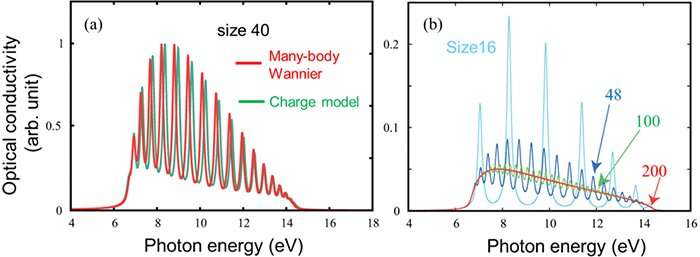Charge model for calculating the photo-excited states of one-dimensional Mott insulators

Assistant Professor Ohmura Shu and Professor Takahashi Akira of the Nagoya Institute of Technology and others have developed a charge model to describe photo-excited states of one-dimensional Mott insulators under the JST Strategic Basic Research Programs. They have also succeeded in constructing a many-body Wannier function as the localized basis state of the photo-excited states and calculating large-system, optical conductivity spectra that can be compared with experimental results.
There has been growing interest in recent years in how the electronic state of a strongly correlated electron system changes on ultrafast time-scales through electric field application or photo-irradiation. For example, experiments demonstrate that when a Mott insulator is excited with a strong light, holons and doublons are created and metallize swiftly. To understand this physical mechanism, it is necessary to conduct a theoretical calculation of the wave function of the system. The electronic state of a strongly correlated electron system can be described with an extended Hubbard model. However, given the capacity of existing computers, it was not possible to calculate the wave function for a large system that can be compared with experimental results or to use it to obtain the light spectrum even for one-dimensional systems with the simplest of electronic states.
Therefore, a charge model has been developed under the one-dimensional extended Hubbard model that can be used to accurately handle charge fluctuation in addition to the spin-charge separation characteristics of one-dimensional Mott insulators. By comparing the precisely calculated optical conductivity spectra of the extended Hubbard model and the charge model, it was demonstrated that charge fluctuation is essential to the description of the photo-excited states and that the charge model is effective. Moreover, a many-body Wannier function that integrated the effects of electron-electron interactions by applying information science methods to the charge model was constructed, resulting in the successful acquisition of optical conductivity spectra for systems consisting of more than 100 atoms or molecules that could be directly compared with experimental results.
-

Comparison of optical conductivity spectra between the charge model and the extended Hubbard model. Optical conductivity spectra for a system consisting of 14 atoms are shown. The spectrum calculated from the charge model (red slid line) quantitatively coincides with that calculated from the extended Hubbard model (black broken), while that calculated without charge fluctuation (blue solid) shifts about 2 eV (electron volt). Credit: 2009 The American Physical Society -

Optical conductivity spectra calculated by using many-body Wannier functions. (a) Comparison of the charge model and the method of the many-body Wannier functions. The method of the many-body Wannier functions well reproduces the optical conductivity spectrum calculated from the charge model for a system consisting of 40 atoms. (b) System size dependence of the spectra calculated by using the many-body Wannier functions. The spectral distribution becomes broad as the system size increases until the size reaches about 200. Credit: 2009 The American Physical Society
The information-science technology used in this research should be applicable to the theoretical analysis of photo-induced phenomena of a wide variety of strongly correlated electron systems. This discovery of the mechanism of the photo-induced electron dynamics is expected to lead to the development of ultrahigh-speed optical devices using strongly correlated electron systems.
More information: S. Ohmura et al, Effective model of one-dimensional extended Hubbard systems: Application to linear optical spectrum calculations in large systems based on many-body Wannier functions, Physical Review B (2019). DOI: 10.1103/PhysRevB.100.235134
Journal information: Physical Review B
Provided by Japan Science and Technology Agency





















